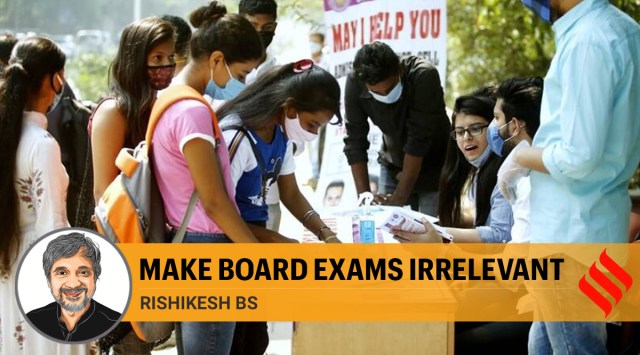- India
- International
NEP 2020 has the answer to the question of impossibly high cut-offs
For the problem of unreasonable cut-offs to be rooted out, the assessment reforms that NEP envisages, for both school-leaving and higher education entrance, is critical. Both of these reforms have to take place simultaneously
 Students at the DUSU helpdesk on the first day of admission at Delhi University. Praveen Khanna
Students at the DUSU helpdesk on the first day of admission at Delhi University. Praveen KhannaWhen Delhi University announced the first list of admission into undergraduate programmes in its 90 colleges earlier this month, the cut-offs reached 100 per cent mark in some courses offered by a few colleges. But this is neither surprising nor unexpected. According to the most recent All India Survey of Higher Education (AISHE 2018-19), Delhi’s gross enrollment ratio (GER) is 46.3 per cent (the national GER is 26.3 per cent). This means that almost every second youth in Delhi between the age of 18 and 23 is enrolled in a higher education programme. But the aspirations of Delhi’s youth are not met by adequate high-quality Higher Education Institutions (HEIs, including universities and standalone institutions), leading to unreasonably high cut-offs. In some HEIs, for courses such as computer science or English literature, the cutoff is in the high 90s, even for aspirants from socio-economically disadvantaged groups.
What we have been seeing in Delhi for more than a decade is also seen in a few other states, where the GER is close to 50 per cent. Today, it is a handful of states, and tomorrow it will be the entire country. According to India’s commitment to the Sustainable Development Goals (SDG) for 2030 and the National Education Policy 2020 target, we are aiming to ensure 100 per cent enrollment across our school stages, from pre-primary to the secondary stage. As we move towards this target, there will be a further rise in applications for higher education programmes for which the NEP 2020 has set a target of 50 per cent by 2035 — which would mean an additional 35 million seats to be created in HEIs across the country. If the cut-off marks are already at unreasonable levels, we can imagine the scenario with a doubling of prospective students. Unless something transformative is done, we are headed towards a rise in the number of unemployed graduates (due to poor quality education) and a generation of disenchanted youth (due to the systemic failure in equipping them with required skill sets).
We have nearly 1,000 universities and almost 40,000 colleges spread across the country. Many of the universities affiliate more than 1,000 colleges. If such large affiliations indicate the unreasonable number of colleges that universities are trying to manage, 16.3 per cent of the colleges have an enrolment of fewer than 100 students.
Editorial | Delhi University’s cut-off crisis speaks of a broken education system
NEP 2020 recommends moving into a higher education ecosystem that consists of large multi-disciplinary HEIs, offering undergraduate and graduate programmes, one in every, or nearly every district, in the country. These will be multi-disciplinary universities and colleges; with the latter moving away from affiliation into a degree-granting HEI or a constituent college of the university. Each such institute will aim to have 3,000 or more students. Currently, only 4 per cent colleges have an enrolment over 3,000. By modelling this across the higher education ecosystem, not only will access improve, but it will also make HEIs viable, with all resources in place as is seen in most parts of the developed world. With only half the number of HEIs that currently exist, we will be able to provide access to 70 million students expected in higher education once the country reaches a GER of 50 per cent. This will also allow for closing down of thousands of poor quality HEIs, which snare unsuspecting students, leading to a large number of non-entrepreneurial, unskilled and unemployable graduates.

For the problem of unreasonable cut-offs to be rooted out, the assessment reforms that NEP envisages, for both school-leaving and higher education entrance, is critical. Both of these reforms have to take place simultaneously. In the last decade, when the CBSE experimented on a progressive reform by making Class X board exams optional, very few parents allowed their wards to take that option. Until the school and higher education system are aligned to ensure a paradigm shift, students, parents and the entire country will continue to operate in this vicious cycle.
Using school-leaving marks to create cut-offs is a lazy option employed by the HEIs to reduce the number of applicants, before launching their admission process. School percentages are not good markers of an individual’s readiness to do higher education —and given the serious drawbacks of standardised assessments in our board exams, it is best to get rid of them at the earliest. Instead, school-leaving certificates will have to be based on an array of assessments, including a student’s performance across the secondary level — Classes IX to XII. They will factor in class assignments and tests, leading to the development of students’ portfolios. Post that, admission to higher education is an entirely different set of activities. It may use the portfolio of school assessments as the base, but the admission process ought to assess whether the prospective student has developed the attributes for pursuing higher education.
NEP 2020 envisages assessment reform at the school level, which would make the board exams redundant, and also a common entrance for the liberal arts-based higher education system, which only assesses an applicant’s preparedness to pursue a university education. We need to usher in these reforms at the earliest. If not, the country is at the risk of generating graduates in tens of millions, who will neither have the capacity to generate employment for themselves nor the capability to be employed anywhere.
This article first appeared in the print edition on October 27, 2020 under the title “Make board exams irrelevant”. The writer is associate professor, Azim Premji University
Also read | Explained: What does a 100% cut off in Delhi University actually mean?
EXPRESS OPINION
More Explained
Apr 19: Latest News
- 01
- 02
- 03
- 04
- 05









































